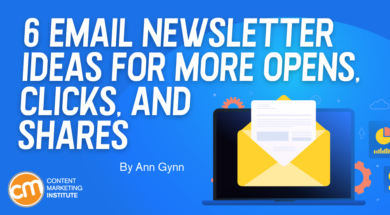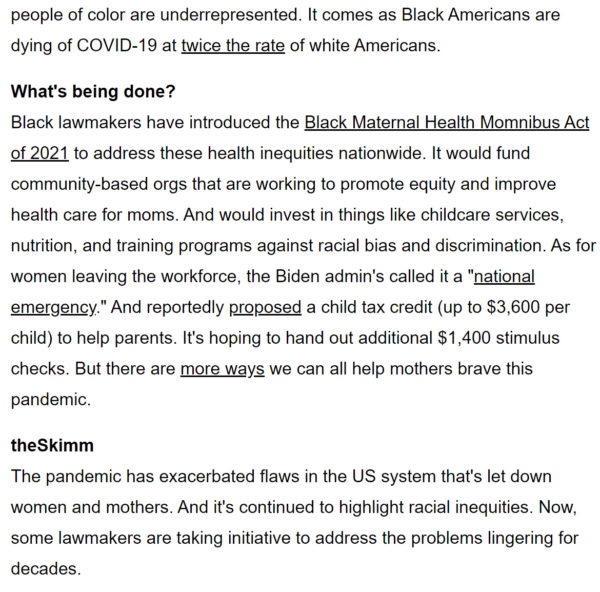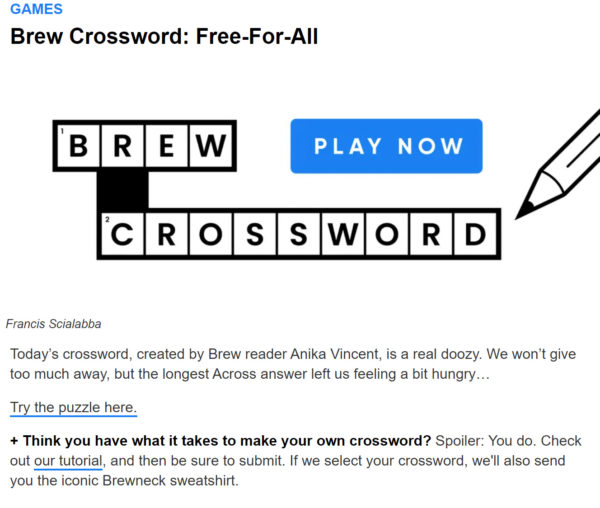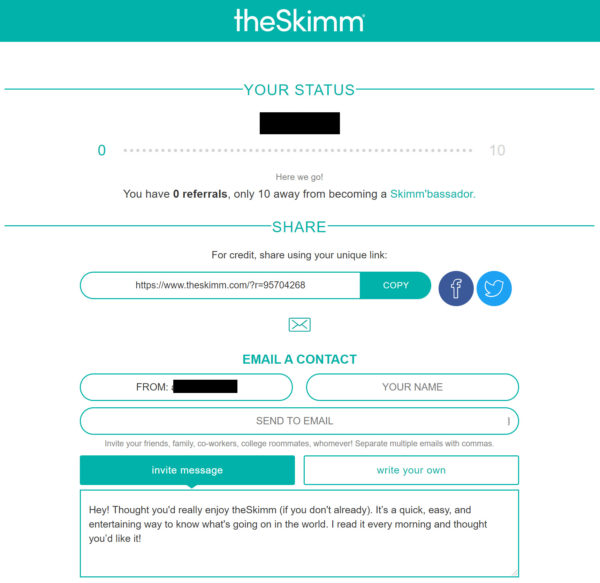6 Email Newsletter Ideas for More Opens, Clicks, and Shares
 Your email newsletter database is valuable. After all, these people signed up to receive your content. They must be eager to consume it, right?
Your email newsletter database is valuable. After all, these people signed up to receive your content. They must be eager to consume it, right?
And yet, the average email open rate in 2020 was 18%. That means less than one of every five subscribers you’ve earned looks at the content you send.
Some daily e-newsletter brands have found better success. Morning Brew, theSkimm, and The Hustle have risen to the top of the newsletter game with open rates approaching 50% and subscriber totals that make the rest of us green with envy. The Hustle built something so good that marketing software company HubSpot recently bought it in a deal valued at $27 million.
What does it take to get people who’ve already expressed an interest in your brand’s content to open and (hopefully) read it? Here are some lessons content marketers can learn from these email newsletter successes.
What does it take to get subscribers to actually open your #email newsletter? @AnnGynn offers 6 bright ideas from the @MorningBrew, @theSkimm, and @TheHustle via @CMIContent.CLICK TO TWEET
1. Don’t require a click
Morning Brew, theSkimm, and The Hustle newsletters are self-contained. Readers can consume and understand the topic without ever having to click to go to the brand’s website to learn more.
That may seem counterintuitive to marketers. Yet, if your content’s goal is to build a valuable relationship with your audience, it makes sense: Don’t make your audience work harder for your content than they have to.
Each newsletter also gets to the point quickly. For example, theSkimm boils its few-hundred-word feature story into a simple paragraph that appears at the end of the main article. Here’s one for the effect of the pandemic on women and mothers:
The pandemic has exacerbated flaws in the US system that’s let down women and mothers. And it’s continued to highlight racial inequities. Now, some lawmakers are taking initiative to address the problems lingering for decades.

By thoughtfully designing your e-newsletter with the audience in mind, you can better address varied reading habits. Create subheads and snippets for at-a-glance readers, and offer longer pieces and additional resources for in-depth readers. Keep in mind: Readers don’t exhibit the same behaviors every day. Someone may be short on time one day but have more time to read on another day. Or a topic may pique the interest of one reader but leave another less intrigued.
Create subheads and snippets for at-a-glance readers, and offer longer pieces and additional resources for in-depth readers, says @AnnGynn via @CMIContent. #EmailMarketing #NewslettersCLICK TO TWEET
2. Craft custom subject lines – and be consistent
Even though they signed up to receive your content, few people will work to find it in a crowded inbox. Make it easier for them to spot your e-newsletter – put your brand voice and visual identity in the subject lines. A consistent look will draw the eye more than random words.
Both The Hustle and Morning Brew use emojis in their subject line. The Hustle chooses an emoji relevant to the content of the day.

Morning Brew uses the same emoji – a coffee mug – in all its daily newsletters. The image smartly aligns with its brand.

Although it forgoes emojis in its subject line, theSkimm stays consistent by putting “Daily Skimm:” at the start of each subject line.

Consistent brand subject lines pay off for each of these newsletters. I’m partial to the Morning Brew’s consistent emoji for several reasons. It echoes the brand name, and it takes up little space, which allows more of the news in the subject line. I’m not a big fan of using “Skimm” twice in its emails – the sender and the subject line seem like overkill when space is at a premium.
Visual consistency helps your #EmailNewsletter stand out in crowded inboxes. @MorningBrew’s coffee emoji cleverly echoes the brand name, says @AnnGynn via @CMIContent.CLICK TO TWEET
3. Give credit to your voices
Putting names to the people behind your content lets your audience see your brand as made up of living, breathing people – not a faceless corporation only concerned about sales.
All three newsletters incorporate that human side by crediting the people behind the newsletter – incorporating them at the end just like the credits used for movies. The Hustle includes a link to each writer’s social media profile and uses nicknames as appropriate.
Here’s how a recent credit line looked:
![]()
Yes, bylines give credit to your writers. But using only bylines omits the other valuable parties in the publishing process (editors, proofreaders, designers, artists, etc.)
4. Let readers have some fun
Even if your content focus is informational or educational, you can still offer subscribers the chance for some fun. Morning Brew includes a games section featuring the Brew Crossword.

Not all newsletters need a crossword puzzle, but most can benefit from a light touch at some point in the content. Think about including a joke, a meme, a video, or even a quote – as long as it’s relevant to your core topic and is in line with your brand voice.
Think about including a relevant joke, meme, video, or even a quote in your #EmailNewsletter, says @AnnGynn via @CMIContent.CLICK TO TWEET
5. Ask what your readers think
Open and click-through rates are helpful data. But that data identifies the action readers took – not whether they liked the content. Nor does the data indicate the reader’s overall thoughts on the newsletter.
In every newsletter, The Hustle asks readers to let them know what they think – without having to fill out a form or send an email. They offer three simple visual options that require only a click. (The click goes to a thank-you page with an optional space to explain the vote.)

Feedback from readers can be challenging, and it tends to come from one type of reader – those who don’t like something. You might also get a sliver of response from your biggest fans. By making feedback as easy as The Hustle does, you could get more responses from the group in the middle. Results from a survey like this can be viewed daily to assess a topic and quarterly to see what works better and what doesn’t work well overall.
Make #EmailNewsletter feedback easy – as @TheHustle does – and you’ll hear from more than just your haters, says @AnnGynn via @CMIContent.CLICK TO TWEET
6. Turn your email audience into influencers
Most newsletters ask readers who liked what they read to share or invite others to read or subscribe. And most brands treat that invitation only slightly better than the microscopic text to unsubscribe.
The Hustle, Morning Brew, and theSkimm all take better advantage of their interested readers. Each runs sharing programs that reward readers who invite others to receive their emails.
theSkimm tracks referrals so readers can see how far away they are from receiving Skimm’bassador status, which requires 10 referrals. (As the name says, Skimm’bassadors are brand ambassadors who are invited to an online community and private events as well as to receive exclusive content.) This is the landing page from theSkimm for its “share” community:

Asking readers to forward the email is an OK step. A share incentive program makes it easy to keep track of who shares your newsletter (and with whom). Make it simple with prepopulated fields (like theSkimm does). You’ll find readers will be more likely to share and do it more effectively.
Reflect before you hit send
You invest time and resources to create e-newsletters. No matter your ultimate goal, you first have to get recipients to open them. By considering these six lessons from some of the best in the business, you can make smart adjustments to help your email open rates rise and your subscriber base grow.
Cover image by Joseph Kalinowski/Content Marketing Institute
Author: Ann Gynn
Ann Gynn edits the CMI blog. Ann regularly combines words and strategy for B2B, B2C, and nonprofits, continuing to live up to her high school nickname, Editor Ann. Former college adjunct faculty, Ann also helps train professionals in content so they can do it themselves. Follow Ann on Twitter @anngynn or connect on LinkedIn.
Other posts by Ann Gynn
